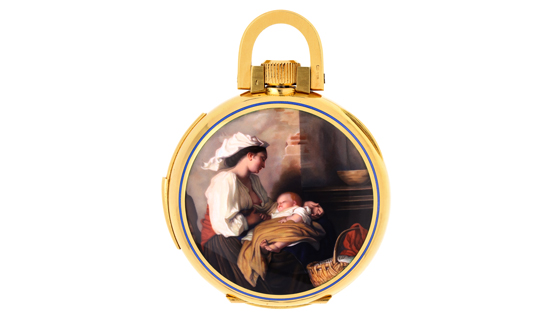
The Musée international d’horlogerie (MIH) unveiled its 2021 acquisitions at an event held in March. More than just objects, these are real symbols that have found their place at the heart of the institution.
Among the 50 or so pieces that have entered the collection, three carry symbolic value extending well beyond their own history.
The MIH acquired a pocket watch with a perpetual calendar and minute repeater comprising two enamel paintings signed Poluzzi-Rohr on one side and Rohr-Poluzzi on the other. Although the timepiece features complications that are admirable in themselves, its main value lies in the two miniature enamel paintings that represent the quintessence of the virtuosity of two of the greatest 20th century enamellers, ensuring this pocket watch bears tangible testimony to the transmission of skills.
Carlo Poluzzi (1899-1978), who at the age of 15 became familiar with the great Geneva tradition when he entered the Geneva enamel-making facility as an apprentice, showed his talent for this craft at an early age. Carefully prepared for the study of drawing through the courses he took at the Ecole des Beaux-Arts, he acquired total mastery of enamel painting. At barely 20 years old, he was already directing the 15 or so artisans exercising their craft in the enamel workshop of Emaux de Genève.
Born in Geneva in 1939, Suzanne Rohr grew up in a family steeped in the classical arts. She took an early interest in drawing and painting, before discovering an exhibition of enamels at Geneva’s Musée d’art et d’histoire (MAH) that thrilled her. She then trained as an enameller and enamel painter at the Geneva School of Decorative Arts, where her teacher was Elisabeth Juillerat, and obtained her federal diploma in 1959. She was the only student in her class.
In the early 1960s, Suzanne Rohr met Carlo Poluzzi, who became her mentor for the next 28 years. Working closely with him, she refined her technique and devoted herself entirely to miniature enamel paintings. The piece acquired by the MIH dates from 1966 and is a milestone in Suzanne Rohr’s accomplishments as a disciple of Carlo Poluzzi. It was through this piece that the work and technical virtuosity of the Geneva-born artist were officially recognised by her master, who co-signed the miniatures with her: Mother and child after Van Muyden (1859) on one side, a representation of children harvesting on the other. The transmission of know-how from one generation to the next is thus visually expressed through this exceptional timepiece, which also echoes the Gaïa Prize awarded by the MIH to Suzanne Rohr in 2019.
The year 2021 was also marked by an important donation from the Laboratoire Temps-Fréquence of the University of Neuchâtel, which gave the MIH its prototype of an atomic clock with a continuous beam of cold caesium atoms. Designed, created and improved from 1999 to 2009 under the supervision of Pierre Thomann (winner of the 2014 Gaïa Prize) at a time when the search for extreme precision was at a turning point in the Canton of Neuchâtel, this equipment was developed to demonstrate and perfect the original continuous cold atom beam concept.
Finally, the Panatere company in Saignelégier donated to the MIH its very first ingot of 316L stainless steel, 100% recycled and produced in a solar-powered oven. This steel comes from production waste collected in the Jura Arc and smelted in a concentrator solar furnace. Much more than an object, this ingot weighing approximately 15kg is a promise for the future in terms of “virtuous luxury” whereby the region’s steel waste becomes raw material for the watch industry. This short supply chain is further reinforced by the Jura company’s intention to install a brand-new patented solar furnace near the watchmaking city. The ingenuity of the company, coupled with the common sense of promoting proximity and sustainability, have led the MIH to offer a choice place to this solar steel ingot which will join the showcase dedicated to new materials.
May 05, 2022


 News
News